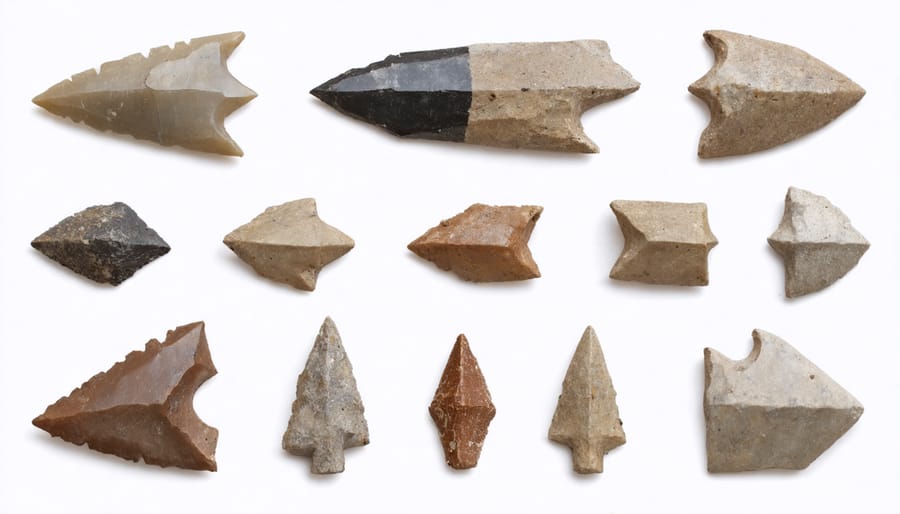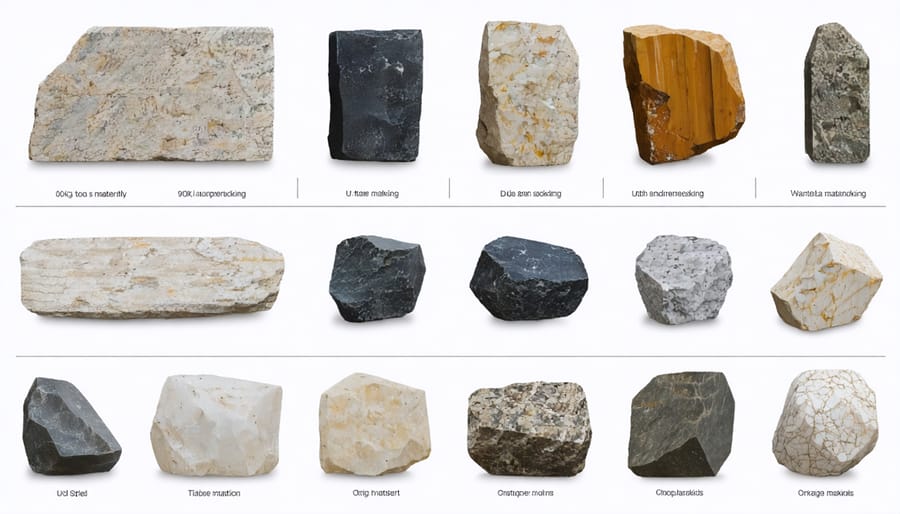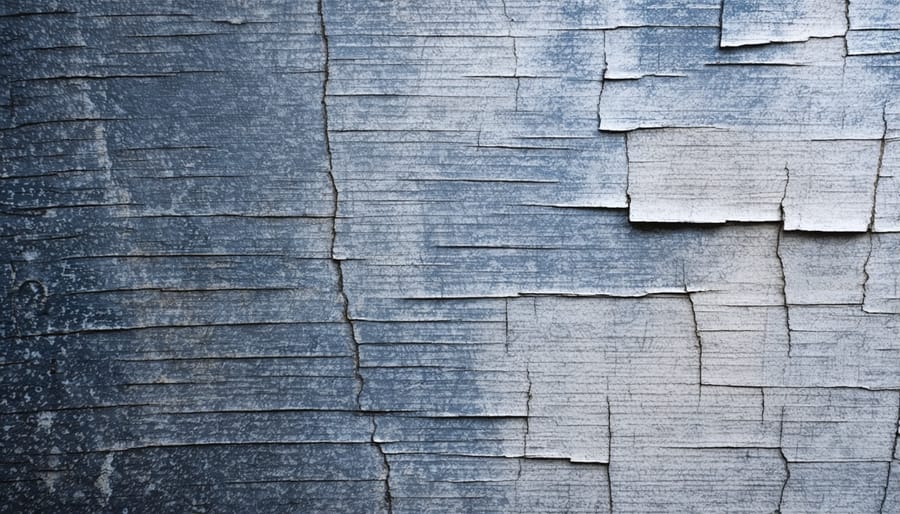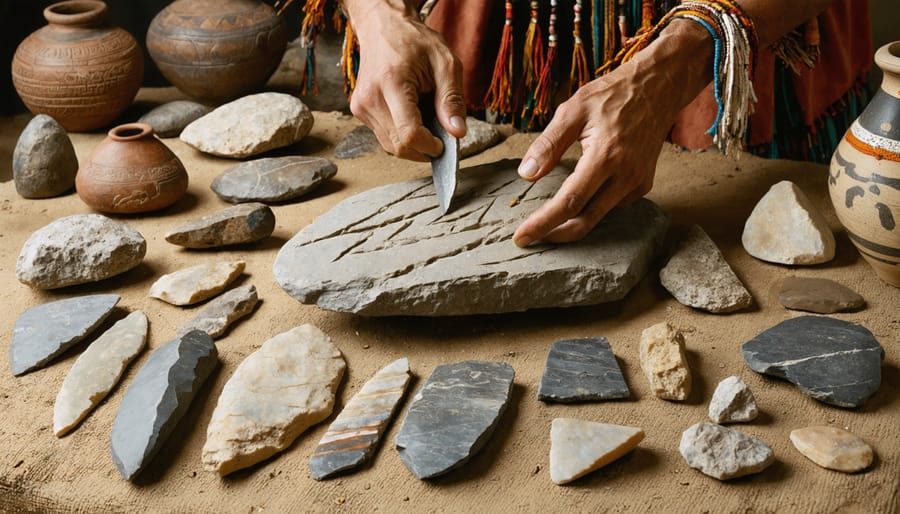Discover the remarkable legacy of Native American lithic technology through precise identification of stone tools – a critical skill bridging archaeological science with ancient stone traditions. Each authentic artifact tells a story of indigenous craftsmanship, from delicately flaked projectile points to carefully shaped grinding implements. Master the essential markers of genuine Indian stone tools: distinctive flaking patterns, material composition, patination development, and wear patterns that reveal centuries of human use. Whether examining artifacts in museum collections or documenting new discoveries, proper identification ensures preservation of irreplaceable cultural heritage while advancing our understanding of Native American technological advancement. This guide equips both seasoned archaeologists and passionate collectors with proven techniques to authenticate, classify, and preserve these significant cultural artifacts, emphasizing responsible stewardship and respect for indigenous cultural property laws.
Common Types of Indian Stone Tools
Projectile Points and Arrowheads
Projectile points and arrowheads are among the most commonly found Native American stone tools, typically crafted from materials like chert, obsidian, and flint. These hunting implements feature distinctive characteristics that aid in identification. The base, or proximal end, often displays notching patterns that helped secure the point to wooden shafts. Look for bilateral symmetry and carefully worked edges, which are hallmarks of authentic pieces.
Most arrowheads exhibit a triangular shape with sharp edges and a pointed tip, though styles vary by region and time period. Larger points were likely used as spear tips, while smaller ones served as arrow points. Key identifying features include flaking patterns along the surface, which show how the tool was shaped through controlled strikes.
When examining these artifacts, check for serrated edges, basal grinding, and flute marks – long channels running from the base toward the tip. These features can help determine both authenticity and approximate age. The degree of patination, or surface weathering, can also indicate age, though this should be evaluated alongside other characteristics for accurate identification.

Scrapers and Cutting Tools
Scrapers and cutting tools were essential implements in ancient Indian toolmaking, characterized by their carefully worked edges and distinctive shapes. These tools typically feature one sharp edge and a blunt gripping surface, making them ideal for processing animal hides, wood, and plant materials.
Side scrapers, commonly made from chert or quartzite, display uniform flaking along one edge and were primarily used for hide preparation and woodworking. End scrapers, featuring a steep working edge at one end, were particularly effective for cleaning animal skins and creating smooth surfaces.
Cutting tools include flakes with sharp edges and more refined blades. These implements often show signs of pressure flaking, creating precise cutting edges. Look for evidence of use-wear along the edges, which appears as small chips or polish from repeated use.
Key identifying features include:
– Intentional flaking patterns along working edges
– Smooth, worn areas where the tool was gripped
– Secondary flaking to maintain sharp edges
– Size typically ranging from 2-6 inches
– Conchoidal fracture patterns characteristic of controlled knapping
These tools often show regional variations in material and design, reflecting local resources and cultural preferences.
Grinding and Pounding Implements
Grinding and pounding implements were essential tools used by Native Americans for food processing. Common examples include mortars, pestles, grinding stones, and manos. These tools typically feature distinct wear patterns from repeated use – smooth, concave depressions on mortars and flat, polished surfaces on grinding stones. Mortars can be identified by their bowl-shaped cavities, while pestles show rounded ends with visible use-wear. Manos, or hand stones, display one or more smooth grinding surfaces and fit comfortably in the palm. When examining these tools, look for striations (parallel scratches) and polish from repeated grinding motions. The size of wear patterns can indicate whether the tool was used for grinding seeds, nuts, or larger food items. These implements are often made from durable materials like granite, basalt, or sandstone.
Material Identification
Common Stone Types
Ancient Indian toolmakers demonstrated remarkable stone craftsmanship through their selective use of various lithic materials. Flint was particularly favored due to its excellent flaking properties and sharp edges, commonly found in shades of gray, brown, and black. This material’s conchoidal fracturing made it ideal for creating precise cutting tools and arrowheads.
Chert, closely related to flint, was another prevalent material used throughout ancient India. Its widespread availability and durability made it a practical choice for everyday tools. While similar to flint, chert often displays a more varied color palette, ranging from white to red and even green.
Obsidian, though less common in Indian contexts, was prized for its glass-like properties and ability to produce extremely sharp edges. This volcanic glass typically appears black or dark gray and was often traded across significant distances.
Other materials included quartzite, characterized by its crystalline structure and exceptional durability, and jasper, valued for its fine-grained texture and rich coloring. Basalt and granite were typically used for larger ground stone tools like grinding stones and axes.
When identifying these materials, observe the stone’s color, texture, translucency, and fracture patterns. Fresh breaks often reveal distinctive characteristics that help distinguish between different stone types.

Regional Stone Variations
India’s diverse geological landscape has led to significant regional variations in stone tool materials across different archaeological sites. In the Deccan region, tools were predominantly crafted from basalt and chalcedony, taking advantage of the abundant volcanic rock formations. Northern India’s stone tools often feature quartzite from the Himalayan foothills, while central India shows extensive use of chert and jasper.
The coastal regions of Western India reveal a preference for fine-grained limestone and agate, materials that were easier to work with and provided sharp cutting edges. Eastern India’s tools frequently incorporate granite and gneiss, reflecting the region’s metamorphic rock formations. In the South, particularly in Karnataka and Tamil Nadu, prehistoric toolmakers utilized dolerite and quartz, materials known for their durability.
These regional variations not only reflect local geological availability but also indicate sophisticated material selection by ancient craftspeople. The Narmada Valley, for instance, shows evidence of specialized tool production using specific varieties of quartzite, while the Son Valley features tools made from locally sourced microcrystalline quartz.
Understanding these regional patterns is crucial for accurate identification and authentication of Indian stone tools. The material composition often serves as a geographical marker, helping archaeologists trace trade routes and cultural exchanges between ancient communities.
Authentication Features
Tool Making Techniques
Native American toolmakers employed sophisticated flaking techniques to create their stone implements, developing methods that have been passed down through generations. The primary technique, known as percussion flaking, involved striking a core stone with a hammerstone to remove flakes in a controlled manner. This process required extensive skill and understanding of how different stone materials fracture.
Pressure flaking, another crucial traditional stone cutting techniques, involved using bone or antler tools to apply precise pressure along the edges of stone tools. This method allowed craftsmen to create finer details and sharper edges, essential for tools like arrowheads and scrapers.
The manufacturing process typically followed a systematic approach: first, selecting appropriate raw materials based on their fracture properties; second, creating basic tool shapes through percussion flaking; and finally, refining the edges through pressure flaking. Evidence of these techniques can be observed in the distinctive ripple marks and flake scars left on finished tools.
Archaeologists can identify specific cultural groups and time periods by analyzing these tool-making patterns. The angle and size of flake scars, the direction of removal, and the overall symmetry of the tool provide valuable information about manufacturing methods and cultural traditions.
Wear Patterns
Identifying authentic wear patterns on Indian stone tools requires careful observation and understanding of how these implements were used historically. Genuine tools typically display consistent wear patterns that develop through repeated use, distinguishing them from naturally damaged stones.
Look for smooth, polished areas along working edges where the tool repeatedly contacted materials. Authentic scrapers often show uniform wear along their curved edges, while cutting tools display characteristic micro-flaking patterns. These wear marks typically appear deliberate and patterned rather than random.
Impact marks on hammerstones should form concentrated clusters rather than scattered indentations. Arrow and spear points may exhibit impact fractures at their tips and wear along their edges from resharpening. Ground stone tools like pestles and grinding stones should show smooth, worn surfaces with directional striations from repeated grinding motions.
Natural damage, in contrast, tends to be irregular and random. Weather-worn stones typically show rounded edges and uniform weathering across all surfaces. River-worn stones display smooth, rounded surfaces without the distinctive working edges found on tools.
Document any wear patterns you observe through detailed photographs and measurements. When in doubt, consult with archaeological experts who can provide professional analysis. Remember that context is crucial – consider where and how the artifact was found, as this can provide important clues about its authenticity and use patterns.

Surface Patination
Surface patination is a crucial indicator when authenticating Indian stone tools. Over centuries, genuine artifacts develop distinct weathering patterns and color changes that can’t be easily replicated. Authentic tools typically display a consistent patina – a thin layer of discoloration caused by chemical reactions between the stone and its environment.
Look for a subtle glossy or waxy appearance on flaked surfaces, which develops through natural handling and exposure. Genuine patination often appears as a yellowish-brown to dark brown coating, though colors can vary depending on the stone type and burial conditions. Tools found in iron-rich soils may show reddish-orange staining, while those exposed to manganese can develop black patches.
Authentication experts examine the uniformity of weathering across the tool’s surface. Genuine artifacts show consistent aging patterns, with patina present in both raised areas and depressions. Recent breaks or damage will appear distinctly lighter than the weathered surfaces, creating a clear contrast that helps verify authenticity.
Be wary of artificial aging attempts, which often show irregular patterns or unusual coloring. Natural patination penetrates slightly into the stone’s surface, while artificial treatments typically remain superficial. Under magnification, authentic patination reveals microscopic pitting and mineral deposits that develop only through extended environmental exposure.
Desert varnish, a dark coating found on tools from arid regions, is another reliable authentication marker, as it forms extremely slowly and is nearly impossible to artificially reproduce.
Preservation and Documentation
Proper preservation and documentation of Indian stone tools are crucial steps in preserving stone heritage and archaeological knowledge. When discovering stone tools, avoid cleaning or treating them before proper documentation. Photograph the artifact in situ (where found) with a scale reference, and record precise GPS coordinates of the discovery location.
Handle stone tools with clean, dry hands or wear nitrile gloves to prevent contamination. Never use harsh chemicals or abrasive materials to clean artifacts. If cleaning is necessary, gentle brushing with a soft brush is usually sufficient. Store tools individually in acid-free containers or bags, clearly labeled with discovery information.
Create detailed documentation including:
– Measurements (length, width, thickness)
– Weight
– Material type
– Tool classification
– Surface characteristics
– Notable features or patterns
– Discovery context
– Photographic documentation from multiple angles
Maintain a detailed catalog system with unique identification numbers for each artifact. Include sketches or detailed photographs showing working edges and distinctive features. For significant finds, consult local archaeological authorities or museums for proper registration and preservation guidance.
Remember that many jurisdictions have specific laws regarding archaeological artifacts. Always check local regulations before collecting or removing stone tools from their discovery site. Consider donating significant finds to local museums where they can be properly preserved and studied for future generations.
The proper identification of Indian stone tools represents more than just academic interest – it’s a vital connection to our shared human heritage. When examining these ancient artifacts, we must approach the task with both scientific rigor and cultural sensitivity. Each tool tells a story of human ingenuity, survival, and technological advancement that spans thousands of years.
As collectors and enthusiasts, we have a responsibility to document and preserve these artifacts properly. This not only helps maintain their historical value but also contributes to our broader understanding of Indigenous cultures and their technological achievements. Remember that many of these items hold deep cultural significance for Native American communities and should be treated with appropriate respect.
If you discover potential artifacts, consider consulting with professional archaeologists or local heritage organizations. They can provide expert guidance on proper documentation and preservation techniques. Additionally, familiarize yourself with local and federal laws regarding artifact collection and protection of cultural resources. By approaching Indian stone tool identification with knowledge and respect, we help ensure these invaluable pieces of history are preserved for future generations to study and appreciate.










